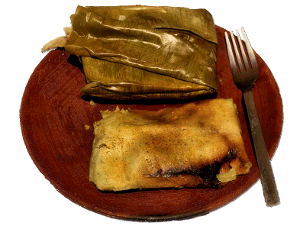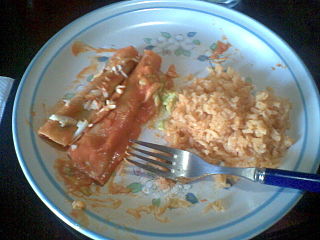
Mexican cuisine consists of the cooking cuisines and traditions of the modern country of Mexico. Its earliest roots lie in Mesoamerican cuisine. Its ingredients and methods begin with the first agricultural communities such as the Olmec and Maya who domesticated maize, created the standard process of nixtamalization, and established their foodways. Successive waves of other Mesoamerican groups brought with them their cooking methods. These included: the Teotihuacanos, Toltec, Huastec, Zapotec, Mixtec, Otomi, Purépecha, Totonac, Mazatec, Mazahua, and Nahua. With the Mexica formation of the multi-ethnic Triple Alliance, culinary foodways became infused.

An enchilada is a Mexican dish consisting of a corn tortilla rolled around a filling and covered with a savory sauce. Enchiladas can be filled with various ingredients, including meats, cheese, beans, potatoes, vegetables, or combinations. Enchilada sauces include chili-based sauces, such as salsa roja, various moles, tomatillo-based sauces, such as salsa verde, or cheese-based sauces, such as chile con queso.

A tamale, in Spanish tamal, is a traditional Mesoamerican dish made of masa, a dough made from nixtamalized corn, which is steamed in a corn husk or banana leaves. The wrapping can either be discarded prior to eating or used as a plate. Tamales can be filled with meats, cheeses, fruits, vegetables, herbs, chilies, or any preparation according to taste, and both the filling and the cooking liquid may be seasoned.

In North America, a corn tortilla or just tortilla is a type of thin, unleavened flatbread, made from hominy, that is the whole kernels of maize treated with alkali to improve their nutrition in a process called nixtamalization. A simple dough made of ground, dried hominy, salt and water is then formed into flat discs and cooked on a very hot surface, generally an iron griddle called a comal.

Tostada is the name given to various dishes in Mexico and other parts of Latin America which include a toasted tortilla as the main base of their preparation.

A quesadilla is a Mexican dish consisting of a tortilla that is filled primarily with cheese, and sometimes meats, spices, and other fillings, and then cooked on a griddle or stove. Traditionally, a corn tortilla is used, but it can also be made with a flour tortilla.

A tlacoyo[tɬaˈkoʝo] is a Mexican dish of pre-Hispanic origin made of masa. Tlacoyos are thicker than fresh corn tortillas and are stuffed with cheese, fava beans, cooked ground beans, chicharron, and other ingredients before being fried or toasted. Tlacoyos can be served as an accompaniment to soups and stews or as appetizers for celebrations. They are made in varying shapes, most being oval and some also triangular.

Salvadoran cuisine is a style of cooking derived from the nation of El Salvador. The indigenous foods consist of a mix of Native American cuisine from groups such as the Lenca, Pipil, Maya Poqomam, Maya Chʼortiʼ, Alaguilac, Mixe, and Cacaopera peoples. Many of the dishes are made with maize (corn). There is also heavy use of pork and seafood. Eurasian ingredients were incorporated after the Spanish conquest.

A chalupa is a specialty dish of south-central Mexico, including the states of Hidalgo, Puebla, Guerrero, and Oaxaca.

A gordita in Mexican cuisine is a dish made with masa and stuffed with cheese, meat, or other fillings. It is similar to the Colombian and Venezuelan arepa. Gordita means "chubby" in Spanish. There are two main variations of this dish, one of which is typically fried in a deep wok-shaped comal, consumed mostly in central and southern Mexico, and another one baked on a regular comal. The most common and representative variation of this dish is the "gordita de chicharrón", filled with chicharron which is widely consumed throughout Mexico. Gorditas are often eaten as a lunch dish and accompanied by several types of sauce.

New Mexican cuisine is the cuisine of the Southwestern US state of New Mexico. The region is primarily known for its fusion of Pueblo Native American cuisine with Hispano Spanish and Mexican cuisine originating in Nuevo México.

Tlayuda, sometimes spelled clayuda, is a handmade dish in traditional Oaxacan cuisine, consisting of a large, thin, crunchy, partially fried or toasted tortilla covered with a spread of refried beans, asiento, lettuce or cabbage, avocado, meat, Oaxaca cheese, and salsa.

Entomatadas are a typical Mexican dish made of a folded corn tortilla which has first been fried in oil and then bathed in a tomato sauce made from tomatoes, garlic, onion, oregano, chile serrano (optional) and salt. The recipes for the tomato sauce vary by cook. The tortilla can be filled with a number of different ingredients, however the most common are chicken, beef, cheese or beans. The chicken and beef have most often been pressure cooked so that the meat is tender and can be pulled apart with the fingers. More tomato sauce is poured on top of the filled tortillas and the dish is garnished with sour cream, shredded cheese and slices of white onion.

Most traditional foods in Guatemalan cuisine are based on Maya cuisine, with Spanish influence, and prominently feature corn, chilies and beans as key ingredients. Guatemala is famously home to the Hass avocado.

A sope is a traditional Mexican dish consisting of a fried masa base with savory toppings. Also known as picadita, it originates in the central and southern parts of Mexico, where it was sometimes first known as pellizcadas. It is an antojito, which at first sight looks like an unusually thick tortilla with vegetables and meat toppings.

Mexican street food, called antojitos, is prepared by street vendors and at small traditional markets in Mexico. Street foods include tacos, tamales, gorditas, quesadillas, empalmes, tostadas, chalupa, elote, tlayudas, cemita, pambazo, empanada, nachos, chilaquiles, fajita and tortas, as well as fresh fruit, vegetables, beverages and soups such as menudo, pozole and pancita. Most are available in the morning and the evening, as mid-afternoon is the time for the main formal meal of the day. Mexico has one of the most extensive street food cultures in Latin America, and Forbes named Mexico City as one of the foremost cities in the world in which to eat on the street.

A flour tortilla or wheat tortilla is a type of soft, thin flatbread made from finely ground wheat flour. Made with flour- and water-based dough, it is pressed and cooked, similar to corn tortillas. The simplest recipes use only flour, water, fat, and salt, but commercially-made flour tortillas generally contain chemical leavening agents such as baking powder, and other ingredients.

Oaxacan cuisine is a regional cuisine of Mexico, centered on the city of Oaxaca, the capital of the eponymous state located in southern Mexico. Oaxaca is one of Mexico's major gastronomic, historical, and gastro-historical centers whose cuisine is known internationally. Like the rest of Mexican cuisine, Oaxacan food is based on staples such as corn, beans and chile peppers, but there is a great variety of other ingredients and food preparations due to the influence of the state's varied geography and indigenous cultures. Corn and many beans were first cultivated in Oaxaca. Well known features of the cuisine include ingredients such as chocolate, Oaxaca cheese, mezcal and grasshoppers (chapulines) with dishes such as tlayudas, Oaxacan style tamales and seven notable varieties of mole sauce. The cuisine has been praised and promoted by food experts such as Diana Kennedy and Rick Bayless and is part of the state's appeal for tourists.




























